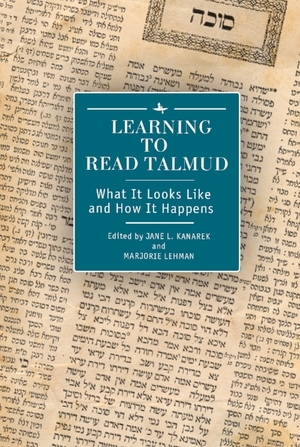Learning to Read Talmud
 Reading Talmud requires sophisticated textual interpretive abilities and has its own particular characteristics. But how do students learn to read Talmud? How can we assess that process? What can we learn about the pedagogic practices that foster successful reading of Talmud?
Reading Talmud requires sophisticated textual interpretive abilities and has its own particular characteristics. But how do students learn to read Talmud? How can we assess that process? What can we learn about the pedagogic practices that foster successful reading of Talmud?
Learning to Read Talmud: What It Looks Like and How It Happens, a volume based on the work of the project and edited by Jane L. Kanarek and Marjorie Lehman, offers studies of courses that develop further an understanding of how students learn to read Talmud, to help instructors in multiple settings improve their practice. This book is available for free download via Open Access.
Table of Contents
| Chapter Title | Author |
|---|---|
|
Learning to Read Talmud: What It Looks Like and How It Happens |
Jane L. Kanarek and Marjorie Lehman |
|
Stop Making Sense: Using Text Guides to Help Students Learn to Read Talmud |
Beth A. Berkowitz |
|
Looking for Problems: A Pedagogic Quest for Difficulties |
Ethan Tucker |
|
What Others Have to Say: Secondary Readings and Learning to Read Talmud |
Jane L. Kanarek |
|
And No One Gave the Torah to the Priests: Reading the Mishnah's Reference to the Priests and the Temple |
Marjorie Lehman |
|
Talmud for Non-Rabbis: Teaching Graduate Students in the Academy |
Gregg E. Gardner |
|
When Cultural Assumptions About Texts and Reading Fail: Teaching Talmud as Liberal Arts |
Elizabeth Shanks Alexander |
|
"Talmud in the Mouth": Oral Recitation and Repetition Through the Ages and in Today's Classroom |
Jonathan Milgram |
|
Talmud That Works Your Heart: New Approaches to Reading |
Sarra Lev |
|
Postscript: What We Have Learned About Learning to Read Talmud |
Jon A. Levisohn |
About the Learning to Read Talmud Project
Drawing on a relatively new and growing body of scholarship in the field of Talmud pedagogy, this project built on the earlier initiative on Bridging Scholarship and Pedagogy in Jewish Studies in two ways:
-
It continued and deepened the Bridging Initiative's focus on the teaching and learning of classical Jewish texts.
-
It recruited creative and thoughtful instructors of Talmud to study their own practice and their students' learning.
In spring 2016, we convened a small cohort of scholars of rabbinic literature to examine what it means to learn to read Talmud and how we teach our students to do so. Drawing on a relatively new and growing body of research that seeks to bridge the worlds of academic Talmud scholarship and scholarship on pedagogy, we thought together about how our students construct their understandings of Talmud and how we, as scholars and teachers, help them to do that. We sought to move beyond impressionistic understandings of our teaching and investigate what we mean by learning to read Talmud and the ways in which we translate our different understandings into our diverse classrooms.